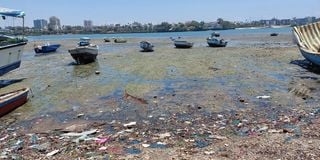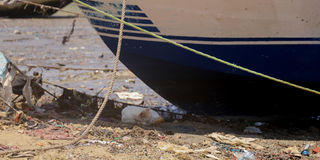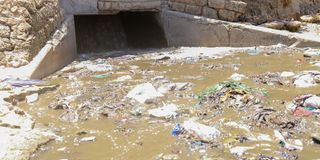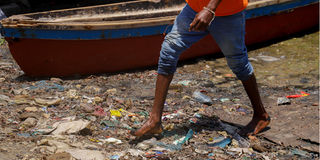Premium
Pollution and illegal fishing methods choking marine life along Kenyan Coast

Fishing boats parked in filth-choked waters at a beach in Mlango wa Papa in Mombasa Old Town.
Every morning for more than a year now, Samir Ali, a resident of Mlango Papa in Mombasa sleeps to the stench of sewage emanating from his backyard. It doesn’t matter if he eats freshly deep-fried fish caught from his fishing errands, his food will taste like sewage.
His windows are now useless, and like any important life choice, he wonders daily whether to open them or not, because, there is no sight to behold, just one to firmly despise. His backyard, once a vibrant beach, is now a graveyard of plastic, old and torn clothes, old and rugged gunny bags, twigs, and old vehicle tires.
Here, houseflies and crows exist in abundance, foraging on human waste and algae that has stuck to God’s earth like sin.
The sewage, which pours like a waterfall, makes its way down to the Indian Ocean, to decide the fate of its fish, and their consumers.
The constant flow has left the ground unsteady, so much so you never know whether your foot will land on firm ground or sink into the filth.
Unlike Samir, with thick-sole sandals, some fishermen walk barefoot across the sewage and into the ocean, as some dig their bare hands into some sections, collecting worms to use as bait.

A fishing boat parked at a beach in Mlango wa Papa area in Mombasa Old Town surrounded by filth.
Unlike Samir’s backyard, whose water boasts of cream brown colour, the opposite side, called Mkomani, boasts of five-star hotels and trendy apartments, a clean beach with white sand and blue water. Samir, a husband to two and father to 11, took to fishing as a job after dropping out of school.
He blames the polluted environment on the neighbourhood, as he says that his neighbours have taken to throwing their garbage into the beach at night, and a broken sewage that landlords have failed to repair.
“We have tried all we can but nothing is yet to change. This sewage that originates from people’s toilets, used to be drained through a pipe, into the ocean, but it clogged,” says Samir.
“The fish have since disappeared. In the past, when you walked on this beach, you were sure to find tiny fish swimming in abandoned car tyres. Now they are nowhere to be seen because of chemicals and dirt. They have fled to the deep seas now. We used to go fishing, nowadays we just go to try our luck,” he adds.
Samir says that he and other fishermen are lucky not to have fallen ill, even though they often have to step on faecal matter on their way to and from the ocean. Neither have their chicken, which forages for food in the same environment.
“You may tell your neighbour about the dangers of throwing garbage into the beach, but you will never know whether they will take your advice or decide to throw the garbage at night when no one is watching. No one is going to stay here to watch those who are throwing garbage because we have families to care for,” says Samir.
“The Kenya Ports Authority (KPA) have dug the ocean for sand but we cannot block them because we do not have the power to do so. They take the sand to their ports. However, they destroyed the fish habitats and left us devastated without any hope of compensation. We have not received any support from the Kenya Fisheries Service nor the county government,” he adds.
At Shimoni, the number of fish and turtles has also declined.
In the past year, Bakari Ali Juma, a fisherman from Shimoni beach management unit, discloses that he has seen 10 turtles floating, dead, after eating plastics and used diapers.
Fish numbers have also dwindled because of illegal fishing methods.
“Fishermen are using spear guns, which are fishing devices designed to launch iron nails to impale fish or other marine animals. Some [fishermen] from Tanzania also practice blast fishing, which involves dropping dynamites in areas that have a lot of fish, which kills them instantly, regardless of size. Fish that are too close to the explosives usually end up being broken into parts,” says Bakari.

Raw sewage flows into the Indian Ocean at Mlango wa Papa area in Mombasa Old Town.
“The explosives also kill corals and break fish eggs. I’m yet to find out where they are obtained from, but I know that a single blast will kill more than 1000 fish. Day and night, they do this, while others go for monofilament nets that have been banned because they capture both young and big fish.
He explains that some fishermen have also resorted to using traditional methods of fishing which involve using powder obtained from dried barks of a specific tree Utupa, which kills fish but is harmless to humans.
He adds that the government is following up on the issue and that around 30 people have been caught because of illegal fishing.
Commenting on illegal fishing, Abraham Songok, KWS Deputy Warden at Kisite Mpunguti Marine Park says that cases of illegal fishing have reduced because of increased awareness, which has seen fishermen understand that they need to preserve fish for later days.
“Fishing methods that have been declared illegal include the use of spear guns, which can kill young fish and even get to those that are hiding. This threatens the growth of fish. Fishermen also use monofilament nets and beach seine nets, that target fish living close to the shore. It is the most destructive form of fishing because it harvests both young and mature fish, and kills corals, says Songok.
“Blast fishing is rarely used now but we have not seen it being used of late. Fishermen know that the use of dynamites to kill fish attracts a heavy sentence, so they do not readily go for that option. We do patrols to ensure that those practising illegal fishing methods are arrested. We as KWS are partnering with Kenya Coast Guard, Kenya Navy, Kenya Fisheries, and Kenya Forest Service to ensure that whatever remaining use of dynamite is eliminated,” he adds.
He also adds that they have retrieved seven monofilament nets from the ocean in the past year in partnership with Kenya Coast Guard and arrested 20 fishermen using monofilament nets and spear guns. He further notes that the park has banned the carrying of single-use plastic bottles, only allowing reusable bottles, even as it ramps up on awareness creation to curb illegal methods and overfishing.

A man wades through a pile of garbage along the beach at Mlango wa Papa area in Mombasa Old Town.
His counterpart, Salim Makomba, a warden at Mombasa Marine Park, who is tasked with coordinating administrative functions and protection of the park, says turtle poaching is the main challenge in the area.
“Turtles are poached for bush meat, and there are those who believe that turtle meat has medicinal value. About five turtles were poached in the past year in the protected area. 15 people were arrested and have already been sentenced,” said Salim.
“To protect them, we make sure that turtle nesting sites are well protected, that patrols and beach clean-ups are done effectively to allow turtles to come out and lay their eggs in places that are secure. We have also told fishermen to release turtles caught accidentally back into the ocean, even if they were caught in open fishing areas,” he adds.
When the world celebrated World Wildlife Day on Friday, United Nations Secretary-General António Guterres called for an “end to the war on nature”, which has seen one million species on the brink of extinction because of the destruction of habitats, fossil fuel pollution and climate change.
In the meantime, UN member states have pledged to reduce the extinction rate and risk of all species by ten times the current rate by 2050. This is according to Csaba Kőrösi, UN General Assembly President.
“We need to resort to our most powerful tool, building broad networks and fostering far-reaching partnerships. Partnership is the key to rebuilding degraded areas and restoring healthy environments. It is also crucial in curbing wildlife-related crimes to successfully protect biodiversity. Indigenous communities must be included in these partnerships. But if we really want to see change, we must boost conservation and protection funding too,” said Csaba.
According to the International Union for Conservation of Nature (IUCN), over 300 million tons of plastic are produced annually, with at least 14 million tons ending up in the ocean. The organisation has also established that 80 per cent of all marine debris, found from surface waters to deep-sea sediments, consists of plastics.
This plastic debris mainly results from “urban and stormwater runoff, sewer overflows, littering, inadequate waste disposal and management and illegal dumping, and threatens the health of marine.
“The most visible impacts of plastic debris are the ingestion, suffocation and entanglement of marine species. Sea birds, whales, fish and turtles mistake plastic waste for prey, and most die of starvation as their stomachs become filled with plastic. They also suffer from lacerations, infections, reduced ability to swim and internal injuries,” says IUCN.
According to the State of the Wildlife Economy in Africa, Case Study of Kenya, released in 2020 by the School of Wildlife Conservation, the fisheries sector contributes 0.5 percent to GDP.
120,873 metric tonnes of freshwater fish are annually valued at about Sh20 billion, with marine fisheries producing 20,000 metric tonnes annually valued at about sh5.3 billion. The sector is largely artisanal and subsistence, employing more than two million people.
The study adds that at least Sh12 billion is lost through illegal, unlicensed and unregulated fishing and that the contribution of the wildlife economy to the national economy is not fully captured due to a lack of data.





